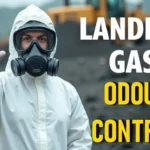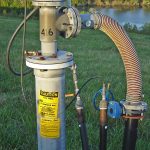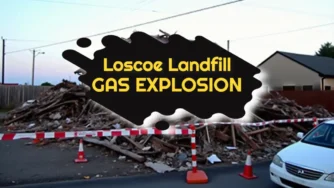Safety for biogas compression equipment involves using explosion-proof components and safety protection devices, with instrumentation such as overpressure and leakage protection. Key operational practices include avoiding ignition sources, implementing proper maintenance and inspections, and using personal protective equipment (PPE).
Key Takeaways for Biogas Compression Equipment Safety
- Proper maintenance of biogas compression equipment can prevent catastrophic failures that could lead to explosions, toxic gas exposure, and facility damage.
- Essential safety components like flame arresters and pressure relief vents are not optional extras but mandatory elements that protect both personnel and equipment.
- Daily monitoring protocols focusing on pressure, temperature, and moisture levels are critical for early detection of potential system issues.
- Protectoseal's specialized safety equipment provides industry-leading protection for biogas facilities, ensuring compliance with stringent regulatory requirements.
- A comprehensive emergency response plan that all team members understand can be the difference between a minor incident and a major disaster.
Biogas compression presents unique safety challenges that demand vigilant attention. When methane-rich gas meets inadequate safety protocols, the consequences can be devastating. One moment of oversight could lead to equipment failure, personnel injury, or worse.
Working with biogas compression equipment safely requires understanding both the visible and invisible risks. Methane, comprising 50-70% of biogas, is not only highly flammable but also potentially explosive when mixed with air in confined spaces. The compression process introduces additional hazards by concentrating the gas and increasing system pressure, amplifying the risk profile significantly. Proper safety protocols aren't just regulatory checkboxes—they're essential lifelines for everyone on site.
Implementing biogas comprehensive safety measures isn't merely about compliance; it's about creating a culture where safety becomes second nature. Protectoseal supports the biogas industry with specialized safety equipment designed to mitigate these risks, including flame arresters and pressure relief vents that are critical for maintaining system integrity under varying operational conditions.
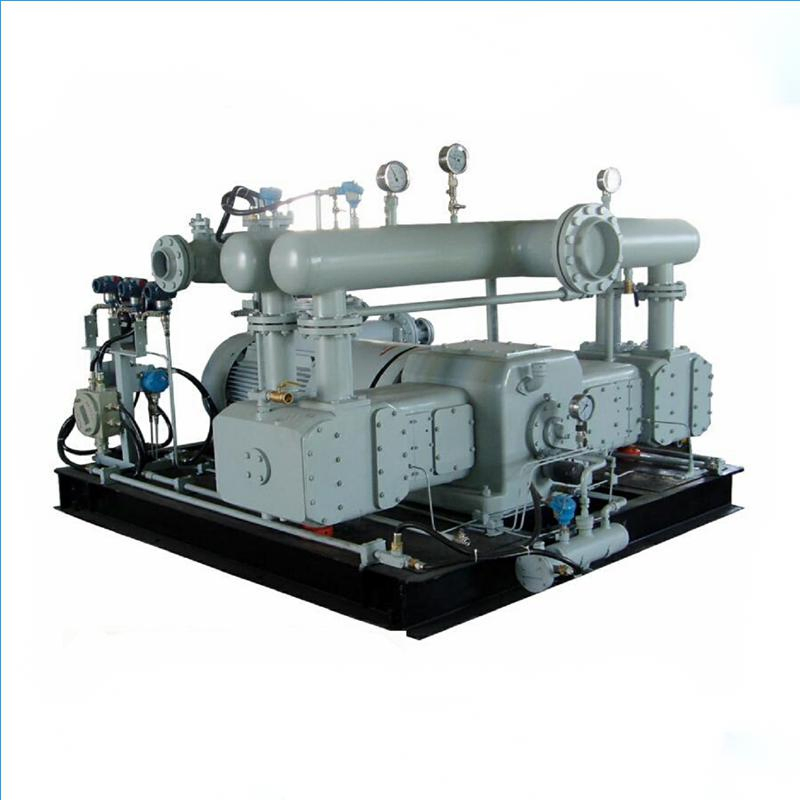
“Biogas Compression and Storage Gas Skid …” from m.made-in-china.com and used with no modifications.
Critical Dangers to Biogas Compression Equipment Safety You Can't Ignore
The compression of biogas concentrates both its energy potential and its hazards. The primary danger for biogas compression equipment safety comes from methane's flammability range (5-15% concentration in air), which creates an explosive atmosphere when improperly contained. Compression equipment operates under significant pressure, sometimes reaching several hundred psi, creating stress points throughout the system. Any failure at these points can result in catastrophic releases of pressurized, flammable gas.
Hydrogen sulfide, commonly present in biogas, adds another layer of risk. This toxic gas can cause respiratory failure even at low concentrations, making leak detection and proper ventilation non-negotiable safety requirements. Equipment corrosion from H₂S and moisture in biogas can compromise system integrity over time, creating hidden failure points that may not be apparent during routine visual inspections.
Mechanical failures in compression equipment can generate sparks or excessive heat—both potential ignition sources in an environment where flammable gas is present. Without proper monitoring and maintenance, even small mechanical issues can escalate quickly into dangerous situations. Electrical components present additional ignition risks if not properly rated for hazardous environments, highlighting the importance of using only explosion-proof electrical systems in biogas compression areas.
List of Gas Industry Standards that may be Applicable for Biogas Compression Equipment Safety
Adherence to established standards provides the foundation for safe biogas compression operations.
The following may be relevant to biogas compression equipment safety:
NFPA 820 (Standard for Fire Protection in Wastewater Treatment and Collection Facilities) specifically addresses biogas hazards in treatment facilities, providing crucial guidelines for system design and operation. API 2000 (Venting Atmospheric and Low-Pressure Storage Tanks) establishes requirements for pressure and vacuum relief systems—critical components in any biogas operation.
ISO 16852 sets the international standard for flame arresters, devices that prevent flame propagation through confined spaces where biogas is present. The ATEX Directive in Europe and similar regulations worldwide classify areas based on explosion risk, determining equipment requirements for each zone. Regular compliance audits against these standards should form part of your facility's safety management system.
- NFPA 820: Fire Protection in Wastewater Treatment Facilities
- API 2000: Venting Atmospheric and Low-Pressure Storage Tanks
- ISO 16852: Flame Arresters Performance Requirements
- ATEX Directive 2014/34/EU: Equipment for Explosive Atmospheres
- ASME B31.3: Process Piping Design and Construction
- IEC 60079: Electrical Equipment for Explosive Atmospheres
The biogas compression equipment safety list provided is not intended to be complete. Always follow the best regulations and guidance for your gas compression equipment and never operate any equipment unless you have all the necessary safety details at your fingertips, and be certain that you comply.
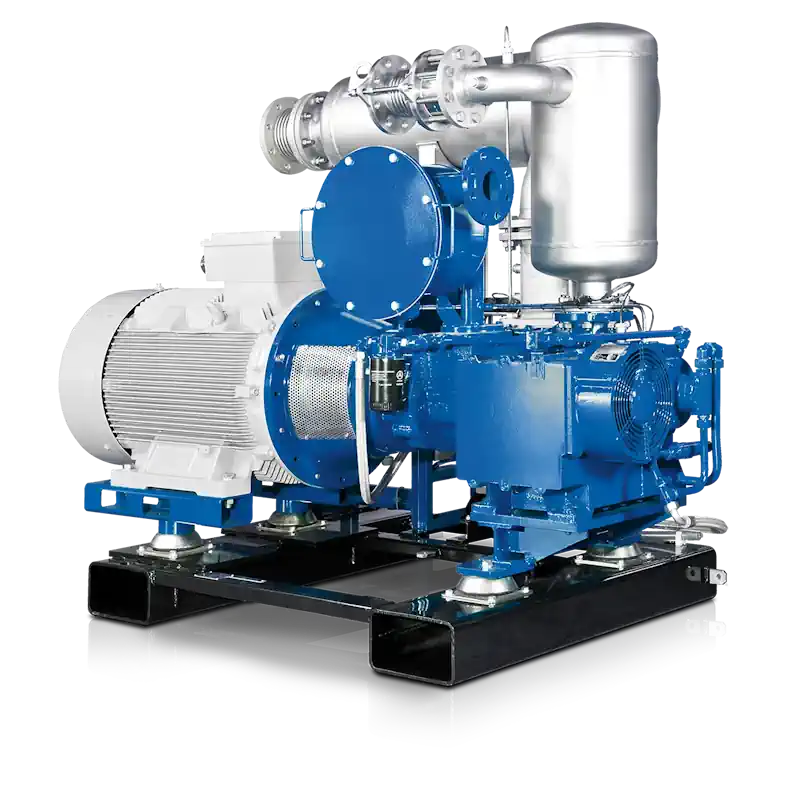
“Biogas Compressor – Aerzen” from www.aerzen.com and used with no modifications.
Essential Pre-Operation Safety Checks
Before initiating any biogas compression operation, a comprehensive safety verification process must be completed. This isn't merely procedural—it's your first and most critical defense against potential incidents. Pre-operation checks establish the baseline condition of your equipment and confirm that all safety systems are functional before introducing flammable gas into the system.
Develop and implement a standardized pre-start checklist that addresses all critical safety aspects of your specific compression system. This documentation should be readily available to operators and updated regularly to reflect system modifications or lessons learned from near-miss incidents.
Training personnel to perform these checks thoroughly rather than perfunctorily creates a culture where safety becomes instinctive rather than enforced.
1. Biogas Compression Equipment Safety – Integrity Verification
Begin every operational cycle with a thorough visual inspection of the compression equipment. Look for obvious signs of damage, corrosion, or wear on critical components, including pipework, flanges, seals, and mounting fixtures. Even minor leaks or hairline cracks can rapidly escalate under operating pressures.
Pay particular attention to connection points between different materials or components, as these junction points often fail first under stress. Understanding the composition and potential hazards of landfill gas can further aid in ensuring equipment safety.
2. Pressure Monitoring System Inspection
Verify all pressure gauges are properly calibrated, undamaged, and showing zero pressure before startup. Inaccurate pressure readings can lead to dangerous operating conditions by masking overpressure situations or failing to alert operators to pressure buildup. Inspect pressure switches, transducers, and transmitters for proper operation and confirm that they're correctly wired to control and alarm systems.
Test pressure relief devices to ensure they activate at their designed set points. These devices represent your last line of defense against catastrophic pressure-related failures. Document all pressure relief valve settings and confirm they match system specifications. Never operate a compression system with bypassed or improperly adjusted pressure relief devices, as this eliminates a critical safety barrier.
3. Gas Leak Detection Setup for Biogas Compression Equipment Safety
Calibrate all gas detection sensors according to manufacturer specifications before each operational period. Sensors degrade over time and require regular maintenance to provide reliable readings. Verify that detection systems are positioned to monitor all potential leak points, particularly around seals, flanges, and valve stems where releases are most likely to occur. For more on waste management practices, consider exploring UK solid waste management companies.
Confirm that gas detection alarms are properly connected to both audible/visual warning systems and emergency shutdown protocols. Personnel should clearly understand the meaning of different alarm levels and their required responses. Perform a functional test of the entire detection system, including alarm activation, to ensure proper operation under real-world conditions. For more information on related technologies, you can explore what is landfill gas and its detection methods.

“Biogas Safety Equipment …” from energenecs.com and used with no modifications.
4. Safety Valve Functionality Test
Test all emergency shutdown valves to verify they function properly and close completely. These valves must be capable of isolating the compression system rapidly in the event of a serious fault. Confirm that manual emergency shutdown stations are accessible, clearly marked, and functioning correctly. Everyone working in the area should understand their locations and operation.
Verify that automated safety valves respond appropriately to their triggering conditions, whether pressure extremes, leak detection, or emergency shutdown signals. The time between trigger and complete valve closure should meet system design requirements.
Check hydraulic or pneumatic actuators for proper pressure and absence of leaks, as these can compromise rapid valve operation during emergencies. Always give biogas compression equipment safety your priority.
5. Emergency Shutdown System Validation
Perform a complete test of the emergency shutdown system at least quarterly, simulating various fault conditions to ensure proper response. This should include verification that all connected equipment—from compressors to ancillary systems—safely stops operation when triggered. Confirm that backup power supplies for critical safety systems are operational and can sustain emergency functions during main power loss. For more information on safety measures, visit ensuring safety in the biogas industry.
Document all emergency system tests thoroughly, including response times and any anomalies observed. Address any identified issues immediately, never deferring safety system repairs regardless of production pressure. Remember that emergency systems often remain dormant until needed, making regular testing the only way to ensure their reliability when a real emergency occurs.
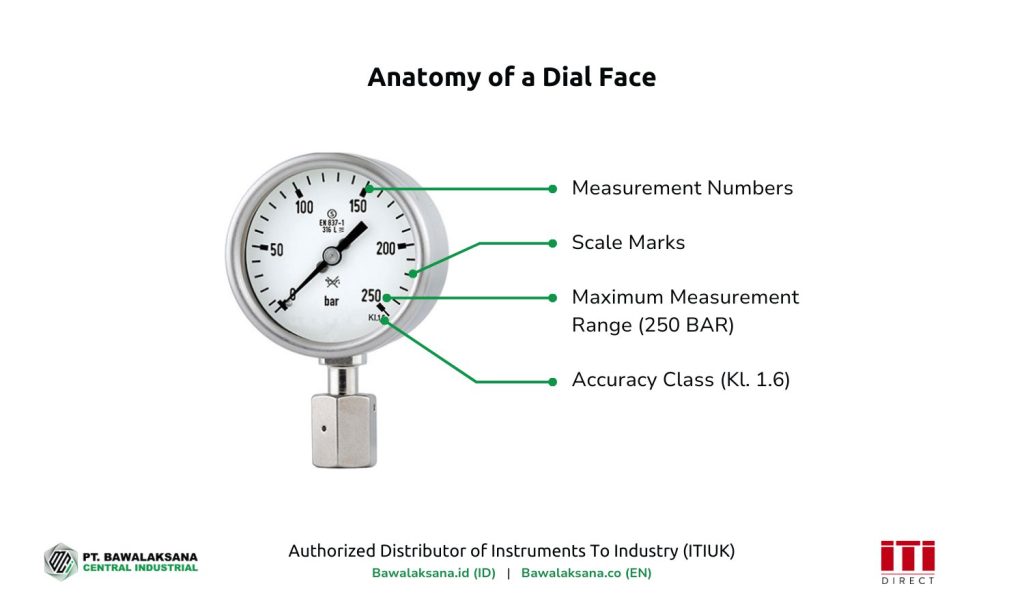
“Read an Industrial Pressure Gauge to ensure biogas compression equipment safety…” from bawalaksana.co and used with no modifications.
Daily Monitoring Requirements for Maximum Safety
Implementing rigorous daily monitoring protocols transforms safety from a periodic concern to a continuous process. Effective monitoring creates an early warning system that can identify developing issues before they become dangerous. Establish clear parameters for normal operation across all critical variables, ensuring operators can quickly recognize deviations that require attention.
Pressure Gauge Reading Protocol
Establish a schedule for recording pressure readings from all gauges throughout the compression system at least twice per shift. Maintaining a log of these readings helps identify gradual pressure changes that might indicate developing problems. Train operators to recognize both absolute pressure limits and rate-of-change concerns, as sudden pressure fluctuations often precede serious equipment failures. For more information on maintaining landfill equipment, check out bulldozers vs landfill compactors.
Compare pressure readings across different system points to identify potential blockages or flow restrictions. Pressure differentials that exceed normal operating parameters warrant immediate investigation. Document acceptable pressure ranges prominently near each gauge and implement a color-coding system that makes dangerous readings immediately obvious to any observer.
Temperature Control Parameters
Monitor compression system temperatures continuously, with particular attention to compressor discharge temperatures, bearing temperatures, and motor winding temperatures. Excessive heat generation often provides the first indication of mechanical problems like insufficient lubrication, misalignment, or impending bearing failure. Implement automated alarms for temperatures that approach critical thresholds to provide early warning of developing issues.
Record cooling system temperatures and flow rates daily to ensure adequate heat removal from the compression system. Insufficient cooling can create a dangerous cycle where rising temperatures accelerate wear, creating more heat and potentially leading to catastrophic failure. Thermal imaging during operation can help identify hot spots not captured by fixed temperature sensors, providing valuable early warning of localized heating issues. For more on managing waste heat, explore food waste processing technologies that can be integrated into your system.
Moisture Level Assessment
Monitor moisture content in the biogas stream before and after compression to prevent condensation within the system. Liquid water in compression equipment can cause mechanical damage, freeze in cool areas creating blockages, and accelerate corrosion of critical components. Implement moisture removal systems appropriate to your specific biogas source and monitor their effectiveness daily through dewpoint measurements or similar techniques.
Inspect moisture traps and drains regularly to ensure they're functioning properly and not becoming blocked or frozen. Accumulated moisture can create significant operational problems and safety hazards, particularly in colder operating environments. Document moisture levels across seasonal changes, as ambient conditions significantly affect moisture management requirements in biogas systems.
Protective Equipment and Biogas Compression Equipment Safety Systems
A comprehensive safety approach requires multiple layers of protection working in concert. Each safety system should be designed with redundancy in mind, ensuring that no single point of failure can compromise overall system safety. Regular testing of these systems must be prioritized equally with production equipment maintenance—safety equipment that fails when needed negates all other precautions.
Critical Flame Arresters Installation
Install flame arresters at all potential ignition pathway points to prevent flame propagation into the biogas system. These critical devices use heat-absorbing metal elements to cool flames below the ignition temperature of the gas, preventing flashback explosions. Position flame arresters between compression equipment and storage vessels, as well as at any point where biogas might encounter an ignition source.
Critical Flame Arresters Installation
Install flame arresters at all potential ignition pathway points to prevent flame propagation into the biogas system. These critical devices use heat-absorbing metal elements to cool flames below the ignition temperature of the gas, preventing flashback explosions. Position flame arresters between compression equipment and storage vessels, as well as at any point where biogas might encounter an ignition source.
Select flame arresters specifically rated for biogas applications and sized appropriately for your maximum flow rates. Undersized units create excessive pressure drop and may fail under high-flow conditions. Regular inspection and cleaning of flame arrester elements is essential, as particulate buildup can reduce effectiveness and increase pressure drop across the device.
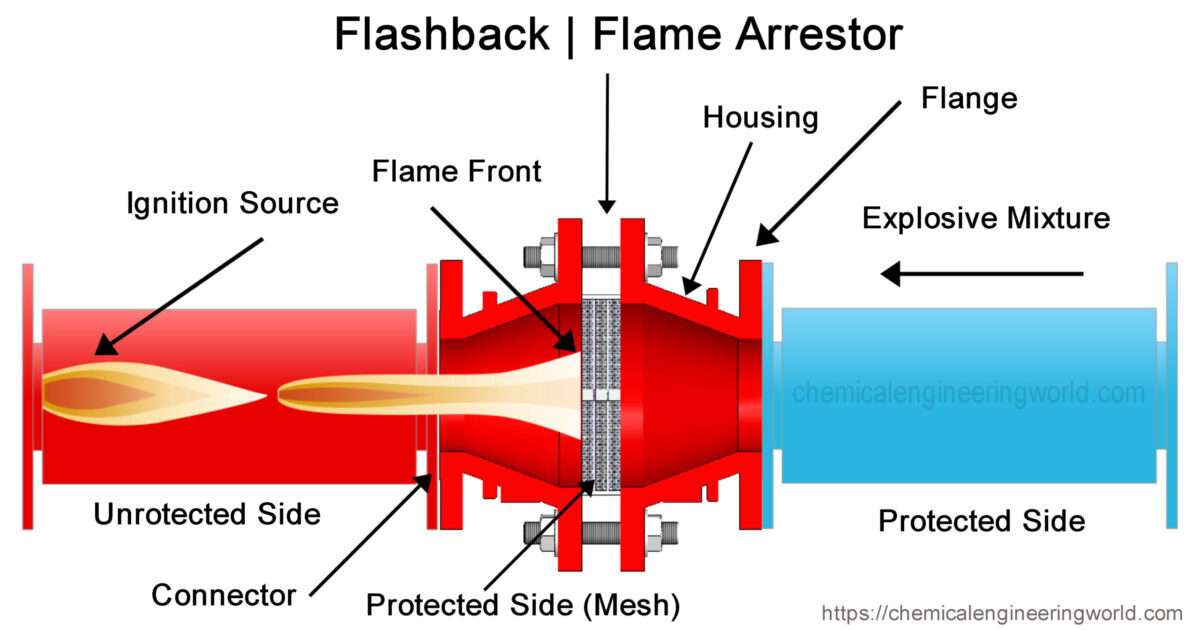
“Flashback | Flame Arrestor Working and …” from chemicalengineeringworld.com where it provides biogas compression equipment safety and image is used with no modifications.
Pressure Relief Vent Placement
Install pressure relief vents on all vessels and equipment sections that could experience pressure buildup. These devices automatically release excess pressure before it reaches dangerous levels that could rupture equipment. Size relief vents according to the maximum potential pressure generation rate, ensuring they can adequately protect equipment under worst-case scenarios.
Direct discharge from pressure relief vents to safe locations away from personnel areas and potential ignition sources. Vent discharge points should be positioned to prevent rainwater ingress while allowing unrestricted gas flow during relief events. Include pressure relief vents in regular maintenance schedules, testing them periodically to verify they open at their specified pressure settings. For more insights on effective waste management, explore landfill designs and operation.
Gas Detection Systems Configuration
Deploy multiple gas detection sensors throughout compression equipment areas to provide comprehensive coverage of potential leak points. Configure systems to detect both methane (for explosion risk) and hydrogen sulfide (for toxicity risk), with appropriate alarm thresholds for each. Position sensors considering both the physical properties of gases (methane rises, H₂S sinks) and ventilation patterns in the equipment area.
Connect gas detection systems to graduated response protocols that escalate from warning alarms to automated emergency shutdowns as concentrations increase. Implement backup power for detection systems to ensure continuous protection during power outages. Regular calibration of sensors according to manufacturer specifications is critical for reliable detection throughout the sensor's service life.
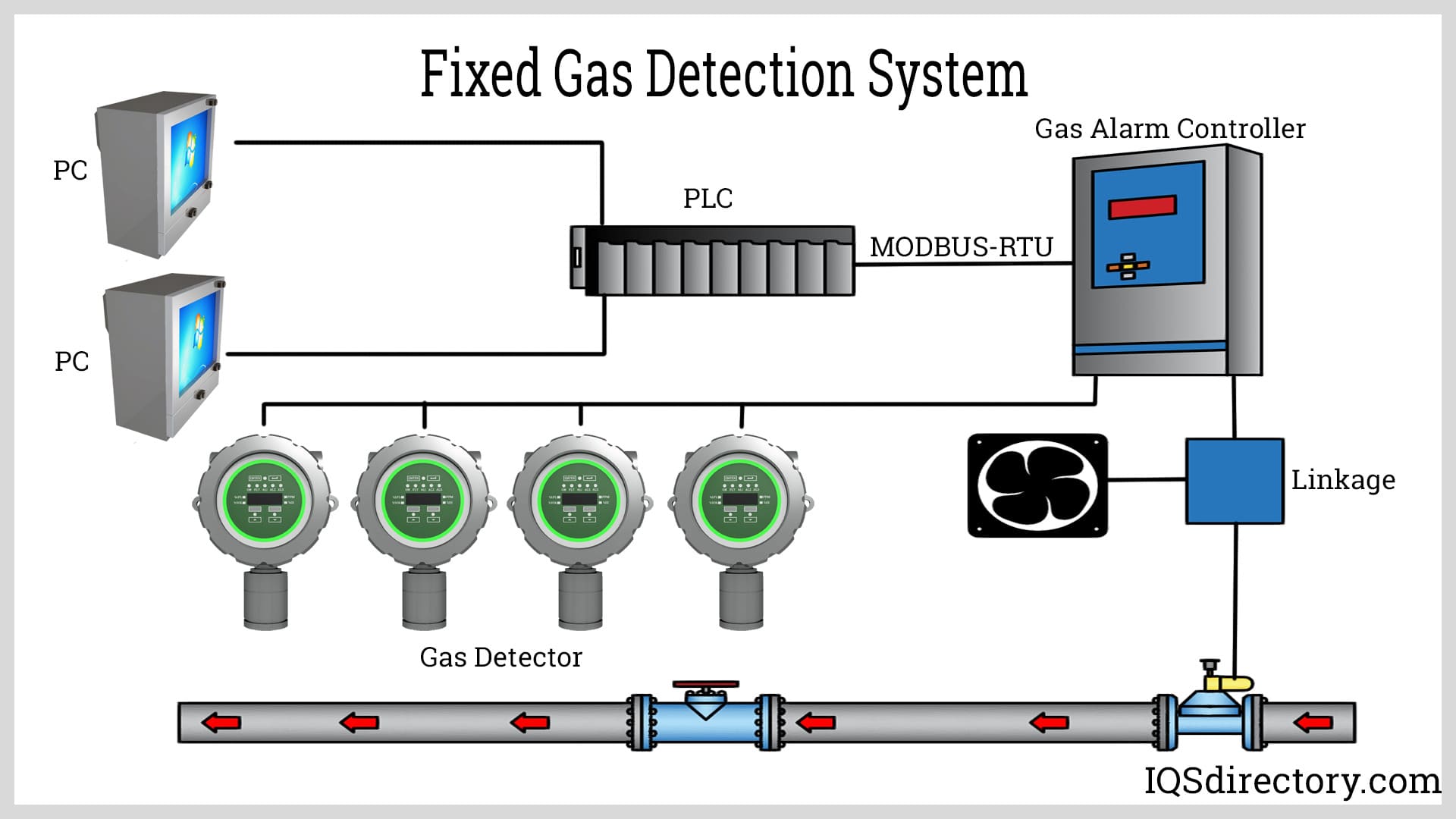
“Gas Detectors” from www.iqsdirectory.com and used with no modifications.
Emergency Response Equipment Access
Position emergency equipment including fire extinguishers, breathing apparatus, and first aid kits in easily accessible locations outside the immediate hazard area. Mark these locations clearly with high-visibility signage that remains visible in low-light conditions. Ensure emergency equipment is appropriate for biogas hazards, particularly fire extinguishers rated for gas fires rather than standard dry chemical units.
Install emergency shower and eyewash stations within quick access of compression areas to address potential exposure to biogas contaminants. Maintain clear access routes to all emergency equipment, never allowing storage or equipment to block these critical resources. Conduct regular inspections of emergency equipment readiness, including checking pressure gauges on fire extinguishers and testing eyewash station water flow.
Biogas Compression Equipment Safety – Maintenance Schedule to Prevent Catastrophic Failures
Preventive maintenance represents your most powerful tool against biogas compression accidents. A systematic approach based on manufacturer recommendations and operational experience can identify developing issues before they become dangerous. Implement a tiered maintenance system that combines frequent basic checks with periodic comprehensive evaluations to ensure no potential failure points go undetected.
1. Daily Visual Inspections
Train operators to perform systematic visual inspections at the beginning of each shift. Focus on identifying obvious abnormalities like fluid leaks, unusual vibration, strange noises, or excessive heat. Document these inspections with simple checklists that prompt attention to critical components and their normal operating conditions.
Establish a baseline for normal equipment appearance and operational characteristics so deviations can be quickly recognized. Use multiple senses during inspections—unusual sounds or odors often provide early warning of developing problems. Create a clear reporting path for even minor observations, fostering a culture where small concerns receive attention before they become serious issues.
2. Weekly Component Testing
Perform functional testing of safety systems weekly, including emergency shutdown controls, alarm systems, and critical interlocks. Verify proper operation of control systems, particularly those governing pressure regulation and temperature management. Weekly checks should include lubrication system inspection, belt tension verification, and cooling system efficiency assessment.
Test gas detection systems weekly by introducing calibration gas to at least one sensor to verify alarm activation and response. Rotate testing through all sensors over time to ensure complete system verification. Document all weekly tests thoroughly, tracking any variations in performance that might indicate gradual degradation requiring intervention.
3. Monthly Comprehensive Assessment
Conduct detailed mechanical inspections monthly, focusing on wear components like seals, bearings, and valve assemblies. Check alignment of coupled equipment using appropriate tools rather than visual assessment alone. Vibration analysis should be performed monthly to detect developing bearing issues or imbalance problems before they cause catastrophic failures.
Inspect electrical components including motors, controls, and instrumentation for signs of heat damage, loose connections, or corrosion. Monthly assessments should include verification of calibration for all critical instruments, particularly pressure and temperature sensors that govern safe operation. Review operational data trends to identify subtle changes in performance metrics that might indicate developing problems.
4. Quarterly Professional Servicing
Engage qualified technicians quarterly to perform comprehensive service including internal inspection of accessible components. This deeper assessment should include oil analysis to identify metal particles indicating internal wear, compression performance testing, and thorough evaluation of all safety systems. Quarterly service provides an opportunity to replace wear items proactively rather than waiting for failure.
Use quarterly servicing to verify compliance with regulatory requirements and industry standards. Document all servicing activities thoroughly, maintaining detailed records of components inspected, measurements taken, parts replaced, and adjustments made. These records provide crucial documentation for regulatory compliance and help identify recurring issues that may require engineering solutions rather than simple maintenance.
Common Compression Equipment Failure Points
Understanding where failures typically occur allows targeted monitoring and maintenance of these critical areas. Historical data across the biogas industry highlights several components that deserve particular attention in any preventive maintenance program.
Seal and Gasket Degradation Signs
Monitor compression seals for discoloration, hardening, or deformation that indicates chemical attack from biogas contaminants. Hydrogen sulfide and organic acids in biogas can rapidly degrade inappropriate seal materials, creating leak paths for flammable gas. Replace seals proactively according to manufacturer recommendations rather than waiting for visible leakage.
Inspect gaskets at flanged connections regularly for compression set, hardening, or chemical attack. Gasket failures frequently occur during system pressure fluctuations or thermal cycling rather than during steady operation. Implement standardized torque specifications for all gasketed connections and verify proper torque during maintenance to prevent both leakage from loose connections and gasket damage from excessive compression.
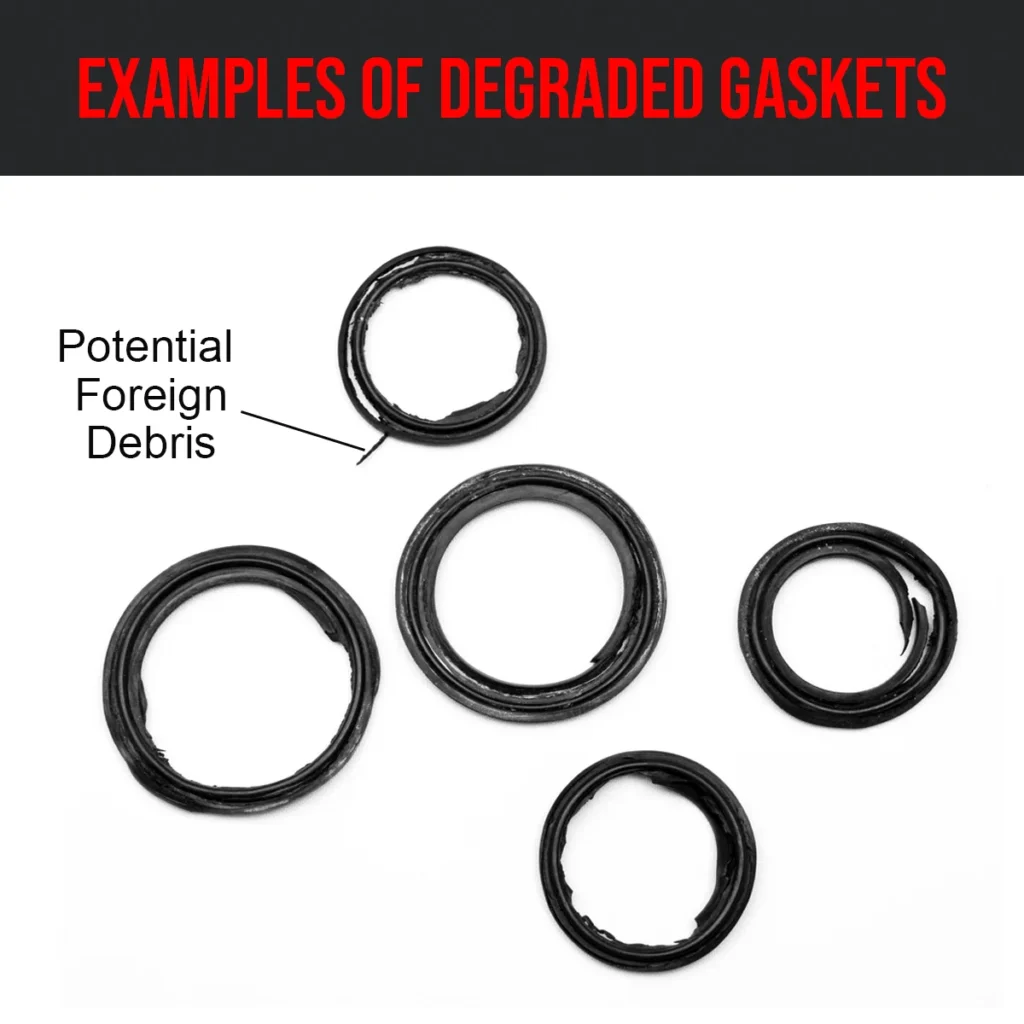
“TNT Tri-clamp Sanitary Gaskets …” from www.hs-innovations.com and used with no modifications.
Compressor Vibration Issues
Establish baseline vibration measurements when equipment is known to be in good condition, then monitor for changes that indicate developing problems. Even small increases in vibration amplitude often signal bearing wear, misalignment, or impending mechanical failure. Implement a formal vibration monitoring program with defined alert and alarm levels based on equipment type and operating parameters.
Pay particular attention to changes in vibration frequency, as these often indicate specific developing faults more clearly than simple amplitude increases. Train operators to recognize abnormal vibration through touch and sound, providing an additional layer of monitoring between formal measurements. Address alignment issues immediately, as even slight misalignment accelerates wear on bearings, seals, and couplings while increasing energy consumption.
Cooling System Problems
Monitor coolant flow rates, pressure differentials, and temperature rise across heat exchangers to ensure adequate heat removal. Compression generates significant heat that must be effectively managed to prevent component damage and potential ignition of gas leaks. Inspect cooling fins and heat exchange surfaces regularly for fouling that reduces thermal efficiency.
Verify proper function of temperature-activated cooling controls, including fans, pumps, and thermostatic valves. Cooling system failures often cascade rapidly, with rising temperatures accelerating seal deterioration and bearing damage. Implement preventive cleaning of cooling system components based on local conditions and fouling rates rather than waiting for temperature increases to signal reduced efficiency.
Control System Malfunctions
Test pressure and temperature sensors regularly against calibrated reference devices to ensure accurate readings. Sensor drift can create dangerous operating conditions by masking actual system parameters or triggering unnecessary emergency responses. Inspect sensor installation points for vibration damage, moisture intrusion, or corrosion that might affect reliability.
Verify proper function of control algorithms through systematic testing of response to simulated input conditions. Control system logic errors or inappropriate parameter settings can create dangerous operating scenarios even when all hardware functions correctly. Maintain secure backups of control system programming and configuration data to enable rapid recovery from electronic failures or corruption.
Lubricant Contamination Indicators
Implement regular oil analysis to identify contaminants that signal developing mechanical issues. Metal particles in lubricating oil provide early warning of bearing wear, gear damage, or cylinder scoring before these conditions create catastrophic failures. Monitor oil condition for signs of water contamination, which accelerates internal corrosion and reduces lubricant effectiveness.
Check oil levels daily and address even small leaks immediately, as they indicate seal failure that could worsen rapidly. Maintain detailed records of oil consumption rates to identify developing issues—increasing consumption often signals internal problems requiring attention. Follow manufacturer specifications for oil change intervals, but adjust based on oil analysis results that might indicate more frequent changes are needed due to operating conditions.
Emergency Response Procedures for Compression Equipment Failures
Even with comprehensive preventive measures, emergency situations can still arise. Developing clear, practical response procedures for various failure scenarios ensures personnel can react quickly and effectively when seconds matter. Regular drills reinforce these procedures, making appropriate responses automatic rather than requiring critical thinking during high-stress situations.
Immediate Actions for Gas Leaks
Train all personnel to evacuate upwind immediately upon detection of a significant gas leak, activating emergency alarms during evacuation. Only specially trained responders with appropriate protective equipment should attempt to address gas leaks. Implement a clear communication protocol that rapidly notifies all affected personnel and outside emergency services when necessary. For more information on effective waste management strategies, explore our guide on waste disposal techniques.
Establish specific response procedures based on leak severity, with clear criteria for each response level. Minor leaks with localized impact might allow controlled shutdown, while major releases require immediate emergency shutdown activation and facility evacuation. For more detailed guidelines, refer to the safety protocols in the biogas industry.
Th following is a typical decision matrix. Requirements may vary, so always apply the guidance appropriate to your installation.
Gas Leak Response Decision Matrix
Level 1 (Minor): Localized leak, gas concentration below 10% LEL, no risk of personnel exposure.
Response: Controlled shutdown, local area isolation, repair planning.Level 2 (Moderate): Contained leak, gas concentration 10-25% LEL, limited risk zone.
Response: Accelerated shutdown, non-essential personnel evacuation, emergency services on standby.Level 3 (Severe): Uncontained leak, gas concentration exceeding 25% LEL or H₂S detection.
Response: Emergency shutdown activation, complete evacuation, immediate emergency services notification.
Provide emergency isolation valve locations in documentation readily available to responders. These valves should be clearly marked, accessible without entering high-risk areas, and regularly maintained to ensure they function when needed.
Remote operated emergency isolation systems provide additional safety by allowing valve operation from safe positions.
Fire Emergency Protocol
Establish a policy that personnel safety takes absolute priority over equipment protection in fire situations. Biogas fires, which can be caused by landfill gas, should never be approached by anyone except trained firefighters with appropriate equipment. Implement automatic fire suppression systems in high-risk areas, ensuring they're appropriate for gas fires and won't create additional hazards.
Design emergency response procedures to focus first on isolation of fuel sources through emergency shutdown systems and isolation valves. Secondary priorities include preventing fire spread to adjacent areas and protecting critical infrastructure from damage.
Train personnel on proper fire extinguisher selection and use, emphasizing that gas-fed fires require fuel source isolation rather than direct extinguishment attempts in most situations.
Overpressure Situation Management
Develop specific response procedures for pressure excursions based on severity and rate of pressure increase. Gradual pressure increases might allow controlled depressurization through normal systems, while rapid rises require emergency pressure relief activation. Implement automated pressure relief systems with appropriate capacity, but also provide manual backup procedures if automated systems fail.
Train operators to recognize precursors to overpressure situations, including downstream blockages, cooling system failures, or control system malfunctions.
Biogas compression equipment safety requires a company culture in which early recognition of developing pressure problems allows intervention before emergency systems must activate.
- Monitor pressure gauge readings continuously during abnormal operations
- Verify pressure relief systems are not isolated or blocked during troubleshooting
- Establish communication protocols for pressure-related emergencies
- Provide clear decision authority for emergency depressurization actions
- Document pressure trends leading up to incidents for future prevention
Never attempt to override or bypass pressure safety systems, regardless of production requirements. The momentary benefit of continued operation never justifies the risk of catastrophic pressure vessel failure. Design maintenance procedures to ensure pressure relief devices remain in service whenever the system contains pressure, using redundant devices when maintenance requires removing primary protection.
Post-incident investigation should include thorough examination of all pressure control and relief components to identify any deficiencies or failures that contributed to the event. Use these findings to improve both equipment design and operational procedures, preventing recurrence through systematic improvements rather than simple component replacement.
Documentation and Compliance Requirements
Comprehensive documentation serves multiple critical purposes: demonstrating regulatory compliance, providing operational guidance, capturing institutional knowledge, and supporting incident investigation when necessary. Develop a systematic approach to documentation that ensures all safety-critical information is recorded, maintained, and readily accessible to those who need it.
Essential Biogas Compression Equipment Safety Records
Maintain detailed maintenance records for all compression equipment and safety systems, including dates, procedures performed, observations, measurements, and parts replaced. These records provide crucial history for troubleshooting and demonstrate compliance with required maintenance protocols. Document all testing of safety systems including emergency shutdowns, pressure relief devices, flame arresters, and gas detection systems.
Preserve training records for all personnel, documenting both initial qualification and ongoing refresher training. These records are often legally required and provide critical evidence of due diligence in safety management. Implement a document control system that ensures the most current procedures, drawings, and specifications are available to personnel while maintaining historical versions for reference.
Regulatory Inspection Preparation
Create a comprehensive regulatory compliance calendar that tracks all required inspections, certifications, and reports. Assign clear responsibility for each compliance activity and implement verification processes to ensure nothing is overlooked. Prepare for regulatory inspections continuously rather than reactively, maintaining compliance documentation in an organized, readily accessible format that demonstrates your commitment to safety.
Employee Training Verification
Implement a formal process to verify that all personnel have received appropriate training before working with biogas compression equipment. This verification should include both general safety training and system-specific operational training. Document competency assessment through testing, supervised operation, and demonstration of emergency procedure knowledge.
Review training content regularly to incorporate lessons learned from incidents, near-misses, and operational experience. Update training materials whenever equipment modifications, procedure changes, or new regulatory requirements emerge. Consider implementing tiered certification levels that recognize advanced skills and authorize personnel for increasingly complex operations or maintenance activities.
Safety Starts With You: Make This Checklist Your Daily Habit
Transform safety from an abstract concept to a daily practice by implementing a practical personal checklist that every team member follows. This creates a culture where safety becomes habitual rather than exceptional, with each person taking personal responsibility for hazard identification and mitigation. The most sophisticated safety systems cannot replace the vigilance of engaged personnel who understand both what to look for and why it matters.
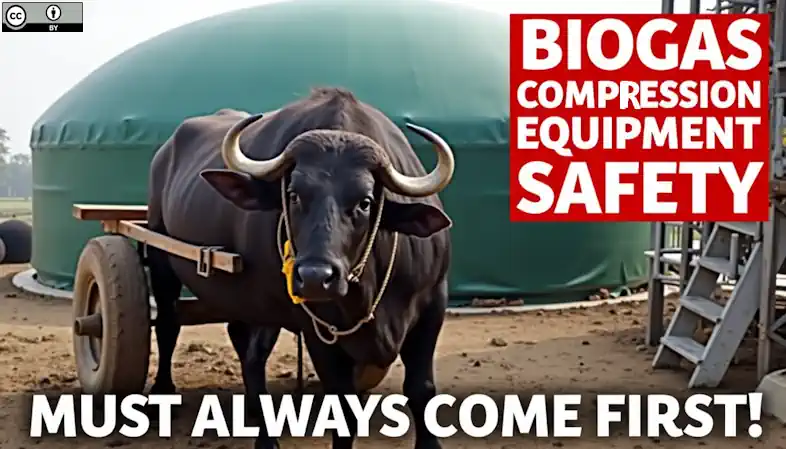
Frequently Asked Questions
Understanding common questions about biogas compression safety helps address concerns proactively. These questions often reveal knowledge gaps that can be addressed through targeted training or procedure modifications. Encouraging open discussion of safety concerns creates an environment where continuous improvement becomes possible.
Safety protocols should never be static documents but evolving guidelines that incorporate new knowledge and adapt to changing operational conditions. Regular review of frequently asked questions helps identify areas where additional clarification or training might be beneficial. For instance, understanding landfill designs and operation can provide insights into adapting safety measures effectively.
Maintaining a “questions welcome” attitude about safety procedures prevents dangerous situations where personnel might follow procedures they don't fully understand or work around requirements they see as unnecessary. Every question represents an opportunity to enhance understanding and potentially improve safety systems.
How often should biogas compression equipment be professionally inspected?
Professional inspection intervals depend on equipment type, operating conditions, and regulatory requirements, but quarterly comprehensive inspections represent an industry standard minimum. These professional assessments complement—never replace—daily operator inspections and regular maintenance activities. High-duty cycle operations or systems processing biogas with high contamination levels may require more frequent professional evaluation.
- Daily: Operator visual inspections and basic monitoring
- Weekly: Functional testing of critical safety systems
- Monthly: Detailed mechanical inspection and vibration analysis
- Quarterly: Comprehensive professional inspection and servicing
- Annually: Complete system overhaul and regulatory compliance verification
Documentation from each inspection level should feed into planning for subsequent activities, creating a continuous improvement cycle. Trends identified through regular inspection often reveal developing issues before they become critical failures. Never extend inspection intervals without thorough risk assessment, regardless of operational pressures or resource constraints.
Consider implementing condition-based monitoring technologies that provide continuous insight into equipment health, potentially allowing optimization of inspection intervals based on actual equipment condition rather than fixed time periods. These technologies can include vibration monitoring, oil analysis, thermal imaging, and acoustic emission detection that collectively provide a comprehensive picture of mechanical integrity.
What are the warning signs that a compressor might fail?
Early warning signs of impending compressor failure often appear subtly before catastrophic breakdown occurs. Increasing vibration, particularly at specific frequencies associated with bearing problems or rotor imbalance, frequently provides the earliest detectable warning. Changes in normal operating sounds—including new noises, increased volume, or altered pitch—should trigger immediate investigation. Rising temperatures at bearings, discharge points, or motor windings often indicate developing mechanical problems or insufficient cooling.
Operational parameters can provide valuable early warnings when tracked consistently. Decreasing compression efficiency, increasing power consumption for the same output, rising oil consumption, or changes in normal pressure differentials all suggest developing problems. The presence of metal particles in lubricating oil, particularly when increasing over time, directly indicates internal wear that will lead to eventual failure if not addressed. Never dismiss minor leaks as inconsequential—they often signify seal degradation that will worsen rapidly under operating conditions, potentially creating both safety hazards and mechanical damage.
Can I operate biogas compression equipment without flame arresters?
Operating biogas compression equipment without appropriate flame arresters represents an unacceptable safety risk that violates industry standards and likely contravenes regulations in most jurisdictions. The potential consequences of flashback without flame arresters include catastrophic equipment failure, facility damage, serious injury, and potential fatalities.
No operational or economic considerations justify the risk of operating without these essential safety devices. If existing flame arresters require maintenance or replacement, the system should be safely shut down and depressurized until proper protection can be restored.
Alternative protection methods such as liquid seals or molecular seals may be appropriate in some applications, but should only be implemented under qualified engineering supervision and in compliance with relevant standards.
What's the proper response to a sudden pressure drop in the system?
A sudden pressure drop in a biogas compression system generally indicates a breach in system integrity that requires immediate attention. The first response should be controlling potential ignition sources in the area, as a pressure drop likely indicates gas release creating a potential explosive atmosphere. Activate gas detection systems to verify whether and where gas might be accumulating, and implement appropriate evacuation protocols based on detection results.
For more information on safety practices, you can refer to Ensuring Safety in the Biogas Industry.
How do environmental conditions affect biogas compression safety?
Environmental conditions significantly impact biogas compression safety through multiple mechanisms. Cold temperatures can cause condensation within gas streams, leading to liquid accumulation, potential freezing, and accelerated corrosion of components. Implement additional moisture removal steps during cold weather operation and increase inspection frequency of components susceptible to water damage.
High ambient temperatures reduce cooling system efficiency, potentially leading to overheating of compression equipment and accelerated degradation of seals and lubricants. Monitor temperature differentials across cooling systems more frequently during hot weather and consider reducing operational load to maintain safe operating temperatures.
Lightning and electrical storms create ignition risks for any released biogas and can damage electronic control systems. Implement enhanced grounding protocols and consider operational restrictions during severe electrical storms.
Seasonal variations in biogas composition from biological sources can create unexpected operating conditions if not properly monitored and addressed. Implement more frequent gas composition testing during seasonal transitions and adjust equipment settings accordingly. Environmental monitoring should become part of standard operating procedures, with specific response protocols for extreme conditions that might affect system safety. For more insights, learn about landfill gas and its impact on biogas systems.
Best Practices in Odour Control Using Landfill Gas Extraction Systems
Landfill gas extraction systems effectively control odour by capturing and treating gases from decomposing waste. Proper system design, strategic well placement, and regular maintenance are crucial for minimizing fugitive emissions and odour complaints, with reductions of up to 85% achievable when these best practices are followed…
US Landfill Gas Resources: A Booming Green Energy Sector
Untapped U.S. Landfill Gas Resources are an Opportunity for Green Investment The American landfill gas (LFG) sector has seen a big change in recent years. It's now a key player in the country's biogas world. Even though it's only 23% of over 2,500 biogas systems now installed nationwide, it captures 72% of all biogas by […]
Flare Systems for Landfill Gas: Improving Environmental Compliance
Landfill flare systems convert harmful methane into less potent carbon dioxide, reducing greenhouse impact. Enclosed flares offer up to 99.9% efficiency. Compliance with EPA regulations and maintenance are critical for optimal performance, ensuring these systems help us meet environmental goals and protect communities from emissions…
Landfill Gas Power Plants
Landfill Gas Power Plants should be installed at all landfills, where the landfill gas (LFG) extraction rate is large enough to sustain a steady flow for long periods (multiple years). A typical Landfill Gas Power Plant for most landfill sites is an internal combustion engine, or possibly a gas turbine. The typical landfill gas power plant is used […]


